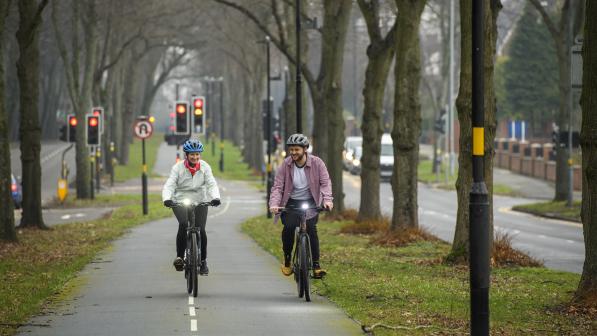Funding for cycling and walking

About the campaign
Through dedicated campaigns and our routine lobbying work, Cycling UK has repeatedly called on governments in the UK to invest more central money in active travel to help solve the environmental and public health crises we all face.
This is essential. We believe that local authorities everywhere must have the financial resources they need to transform streets and neighbourhoods into active travel havens, and pay for programmes to encourage car-dependent and/or inactive people to transform their travel habits.
Active travel is an excellent investment, after all, and the public backs the idea of increasing the money available for it:
- Cycling and walking offers a ‘high’ to ‘very high’ benefit to cost ratio (BCR), the average return being around £5-6 for every £1 invested
- In 2020, a YouGov survey commissioned by Greenpeace found that almost three-fifths of respondents (58%) supported increasing government funding for walking and cycling infrastructure in Britain
To highlight just a few of our funding-related campaigns and lobbying, Cycling UK:
- Backed calls for a Cycling and Walking Investment Strategy (CWIS) in England, analysed the result, campaigned for it to be strengthened and continues to engage with its progress, development and sequel, CWIS2
- At election time, called on devolved administrations to invest at least 10% of their transport budgets in active travel (Wales and Scotland in 2021, and Northern Ireland in 2022). The Scottish Government has agreed to do this by 2024-25, while more than half of the winning candidates in the 2022 Northern Ireland Assembly election pledged the same. Meanwhile in Wales, spending per head of population in 2021 reached record levels at about £24
- Made submissions to the UK Government’s mostly disappointing Spending Reviews
- Defended national and local politicians’ decisions to fund new measures to encourage active travel (for example, low traffic neighbourhoods during the pandemic)
Unfortunately, for a very long time now, active travel has suffered from funding that’s:
- Simply not enough
- Patchy, fluctuating and not guaranteed – some areas have done better/worse than others; and sometimes money has been available, sometimes not. This has made it difficult even for some willing councils to plan long term, be ambitious or decide whether to put resources into developing viable proposals in the first place
- Been squandered/spent on substandard projects
On the subject of patchiness and poor use of funding, there is no sense in handing out active travel funding to councils who are not serious about walking and cycling.
Conditions need to be attached, and there should be consequences for authorities who, for example, ignore design guidance. What’s more, the consequences should impact not just their funding for active travel, but also for wider transport initiatives.
Cycling UK therefore welcomes a new executive agency, Active Travel England established in 2022 and tasked with checking proposed schemes against official design guidance before funding is agreed, and making sure that finished schemes are up to scratch.
We believe that local authorities everywhere must have the financial resources they need to transform streets and neighbourhoods into active travel havens
Spend per head
We are regularly asked how much each nation or individual local authorities spend on active travel per head.
Unless a nation or local authority publishes their own aspirational or current per capita figures, we have to do the maths independently based on the sums they declare and population statistics.
This is not an exact science because:
- Some government funding is ring-fenced for active travel, some is not (but available for it)
- Central funding streams may have different start and end dates (sometimes overlapping, sometimes not)
- Funding may be capital (paying for infrastructure, for example) and/or revenue (such as paying staff salaries)
- Nowadays, much of the funding available is for active travel, that is, cycling, walking and wheeling. Defining ‘wheeling’, the Department for Transport (DfT) says: “Wheeling includes people who use wheelchairs and mobility scooters who may not identify with walking. It is hard, if not impossible, to find out how much is spent on each individual mode, and it’s probably not split evenly – cycle schemes tend to be more expensive than walking schemes
- Some local councils can’t identify how much of their own resources they’ve spent on active travel (for example, if they’ve built infrastructure that benefits active travel but not targeted at it specifically, they may not be able to disaggregate the cost of the active travel element)
- Some local authorities seem to rely on central government for most, if not all, of their active travel funding, while others contribute significantly from their own sources and/or match-fund their allocations from government (they are expected to do this sometimes anyway, or are in with a better chance of receiving the money if they undertake to do so). They can also exact money from developers and use it to fund active travel schemes (‘planning gain’). This means that spend in a local area may be more than the headline allocation from central government, but working it out isn’t straightforward, even if you ask the local authority directly
We’d like to see at least 10% of transport budgets spent on walking and cycling, rising as more people take up active travel

Please see the posts below for our latest estimates and commentary, which include more detailed figures on funding.
For estimates of the cost of cycling schemes, see Transport for Quality of Life’s report to the Department for Transport, Typical costs of cycling interventions (2017).
Cycling UK continues to press for ring-fenced funding for active travel, boosted by maximising the opportunities presented by non-ringfenced streams for wider transport measures or other purposes (for example, housing, high streets and so on).
Principally, we’d like to see at least 10% of transport budgets spent on walking and cycling, rising as more people take up active travel.








